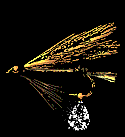

| Home | The JR Cox Story | Selection | Fishing Tips | Location |
 |
 |
|||||
|
||||||
JR's Fly-Fishing Tips.
How does JR decide what insects to copy when he is hand tying flies? He says he checks the aquatic life near the streams. He checks for nymphs under rocks, on overhanging limbs and in the mud. He uses vials to catch and store the insects and he puts them on his bench while he tries to replicate the insect with a fly. "Copies of them make the most productive flies because they represent 80-90% of fish diet year round." He remembers going to Brookville, PA in the fall and early winter. Even in inclement weather he would use the same flies he tied in the spring and still catch a krill full.
Why does he use wet flies instead of dry flies? Over the years he has found wet flies to be far more productive. Nymphs spend most of their life cycle near the bottom of the river. So he uses a sinking line and a wet fly. The life cycle of the nymph may be as long as 3 years. Dry flies depend upon the hatch. Only when the time is right, sun and temperature are right, and only when the age of the nymph is right will they go to the surface, break out of the shell, and start to fly. "When that happens, it's magical." JR tells us that on Oil Creek, near Oil City, PA, fisherman wait for a particular annual hatch… match that hatch with a dry fly and catch fish like crazy. Like a true fisherman, JR won't tell you went that happens exactly. "Oh," he says, "it happens somewhere in April or May…"
JR's Favorite Fishing Spots.
JR's favorite fishing spot is probably Tionesta Creek in Tionesta PA. He's fished all over central and western Pennsylvania. He loves to fish the Allegheny National Forest. In central PA he knows some excellent limestone streams. Most of his life he's fished within PA. But he also fishes for Steelhead trout in the streams that feed into Lake Erie around northwestern PA and in New York State.
Home The JR Cox Story Selection Fishing Tips Location